Stories: Living with Gastroschisis
Gastroschisis is a birth defect of the abdominal (belly) wall. The baby’s intestines stick outside of the baby’s body, through a hole beside the belly button. To learn what it’s like to live with this condition or how families are affected, read these real stories from people living with gastroschisis.
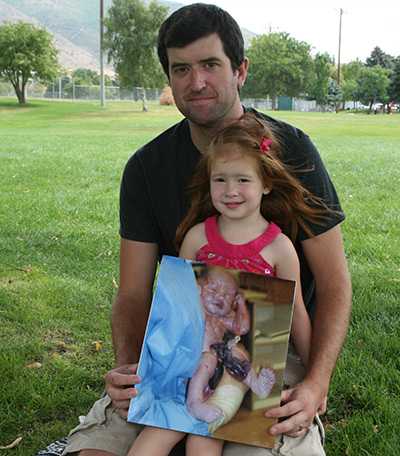
Anna’s Story—Written by her mom, Brooke
When Brooke went in for an ultrasound to find out the sex of her baby, she also learned that her baby girl would be born with gastroschisis. She shares her daughter Anna’s story, about their anticipation of her birth and immediate treatment, the unknown of what her outcome would be, and also their joy of finally bringing their daughter home. Read their story below.
When I was five months pregnant, my husband (shown in the photo with Anna) and I went in for our ultrasound. We were about to learn the sex of our little baby, and our hearts raced in anticipation and excitement as we patiently waited. Finally, the tech told us, “It’s a girl…” I smiled and looked at my husband for his reaction, which was also an elated smile. “…but it looks as though she may have some issues.” At first glance, she thought it may be an omphalocele, but she wasn’t sure. We were given the name of a local specialist who would be able to diagnose her defect correctly.
Two weeks later, we met with the specialist. He proceeded to tell us that the defect was not, in fact, an omphalocele, rather a gastroschisis, put us in touch with his colleague that specialized in this defect. The new specialist explained that gastroschisis is a birth defect in which an infant’s intestines stick out of the body on one side of the umbilical cord. She made us feel as though this was a fairly common condition, and procedures that our baby would need were fairly simple. It was the recovery time that took the longest.
Eventually we were meeting with the specialist regularly. We also met with the doctor who would perform her surgery. He gave us a rough estimate of six weeks to three months before our baby would be well enough to be home with us.
Just as we were coming to terms with the upcoming events, I had a regular scheduled prenatal visit, and my doctor asked me if I was feeling the contractions I was having. I replied that I was, but they weren’t painful, so I wasn’t too concerned about them. I was put on bed rest at the hospital for the remainder of my pregnancy. As the long days passed, I received around the clock care from nurses, interns, on-call doctors, specialists and technicians. Finally, after about three weeks, our doctor informed me that our baby girl needed to come out. She scheduled my Caesarean-section exactly 30 days prior to my due date. We were so nervous and excited at the same time. We’d finally be able to meet our precious little girl, but we still felt helpless and unprepared for what would happen after her birth.
In the early afternoon of a February day, Anna was born. The doctor showed her to us briefly before handing her to the appropriate staff. We were told all of her large intestine was outside of her body, as well as a fallopian tube. Anna was bandaged carefully before being wheeled through the hallways of the hospital and over to the children’s medical center. Once there, her intestines were placed in a protective “silo.” This “silo” was supposed to gently push her intestines back into her abdominal wall with the help of gravity.
After three days, the surgeon informed us that Anna was progressing quickly and was ready for her final surgery. They’d gently push the remaining intestines back into her stomach and stitch up her abdomen. Sitting in the waiting room while Anna was undergoing her surgery will remain to be one of the most nerve-wracking moments of my life. Luckily, it was over fairly quickly. Now came the waiting part. We had to see if she could tolerate the pressure of the intestines in her body, then work on being able to digest breast milk or formula. It was about a week before they attempted giving her my pumped breast milk through a bottle. She took to it quickly but would soon fall asleep or lose interest. Eventually she was eating a decent amount, and the doctors and nurses were pleasantly surprised with her very rapid progress. After only 17 days in the NICU, our little Anna was released and sent home with us. It was as if a great weight had been lifted off our hearts and shoulders. We no longer had to drive an hour to see her, no longer had to get updates from nurses, and we were no longer worried about when we’d finally all get to be together. Our little girl was home!

Ashley’s Story—Written by her mom, Kayte
Ashley is a remarkable young girl, who was also born with gastroschisis. Her mom, Kayte, shares Ashley’s story and the many challenges that she has faced. Kayte also shares how Ashley is an inspiration to countless other families challenged by gastroschisis.
Ashley was born in 2005 with a condition called gastroschisis, which caused her intestines to be outside of her body. The beginning of her life was filled with surgeries and tests, setbacks and worry. She caught an infection in her central line that nearly killed her, and she needed a special transfusion and lots of strong antibiotics to keep her alive. It seemed so unfair that such a tiny person would have to endure so much, but she was a fighter and soon was able to come home. I will never forget the way she looked at the sky with silent awe the first day she finally left the neonatal intensive care unit, or how scary it was at first to have her home without the constant beeping of machines to monitor her. She has always held a sense of wonder and curiosity about the world, and Ashley has a resiliency that other kids her age don’t possess.
Seven years and a few more surgeries later, Ashley is doing really well. She is smaller than other children, which is normal for gastroschisis survivors. She will always be at risk of intestinal kinks and blockages, which makes every stomach bug or tummy ache a worry. She is also hearing impaired from an additional birth defect called microtia. Although her life was initially filled with challenges, Ashley is blossoming into a remarkable young girl who has inspired countless other gastroschisis families with her story.
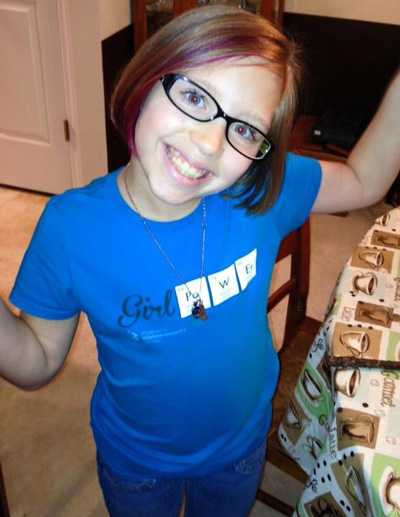
Ashley’s Story—In her own words
Ashley shares her own story of how she is overcoming challenges and thriving.
Hi, I’m Ashley. When I was born I had a birth defect called gastroschisis. I had to have surgery because my intestines were outside of me. I had many surgeries when I was little, but now I’m pretty healthy, although my stomach hurts sometimes and I’m kind of tiny – which can be a side effect of having gastroschisis. Ever since kindergarten I’ve been teased for being small, and because my stomach is sensitive sometimes I don’t do the things kids dare me to, and they’ll laugh at me for being scared. But I have a lot of friends who are nice too!
I also have another birth defect that doesn’t let me hear very well, because my right ear is blocked by skin. I have to wear a hearing aid, but I can’t wear one like other kids do so I wear a BAHA softband. The softband is like a headband, but it holds my hearing aid. I don’t feel comfortable wearing it anymore, because I don’t like the way it feels and it messes up my hair, so in school, the teachers wear a microphone, and I have a speaker on my desk to hear them better. Sometimes being hearing impaired bothers me, because I’m shy and I don’t like asking people to speak louder for me. But I can read lips, unless you have an accent!
I would want other kids to know that despite being small and hearing impaired, I can do a lot of really great things. I like to practice piano, run track, play soccer, and I get good grades in school. I have a lot of amazing friends who have gastroschisis too, and I go to camps where I have friends who use American Sign Language. They make me feel happy because there are other people like me and I’m not alone. Having birth defects isn’t bad, it just sets me apart from other people because I persevere and I’m totally awesome!
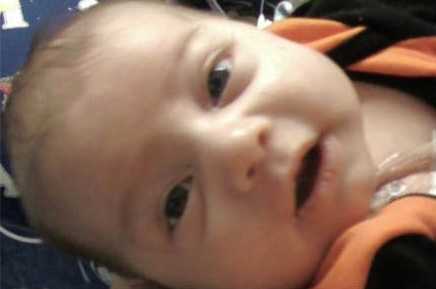
Avery’s Story—Written by his mom, Meghan
Meghan learned of her son Avery’s birth defect early in her pregnancy. She shares her experience of her son’s birth, his short time on earth, and how she is now an advocate for other families affected by gastroschisis. Read her touching story below.
Avery was born at 6lbs 7oz with gastroschisis. We knew of his defect at 12 weeks into my pregnancy, after a blood test came back with concerning hormone levels. An ultrasound confirmed that he had exposed bowel. Avery’s birth defect affects one out of 2,229 babies in the United States.
Prepped for the remaining 25 weeks that the condition was treatable, we met him with rosy expectations. After being wheeled away for surgery immediately following birth, his intestines were placed back inside his body. He spent 107 days in the hospital and underwent multiple surgeries and procedures to attempt to get his affected bowel working. Avery spent 13 weeks fully awake and with a single central line providing his nutritional needs. After a surgery, he had some unanticipated complications. After more surgeries and procedures, it was discovered he was 100% brain dead. Surrounded by our loved ones, we released him to the angels after 107 beautiful days of life.
Fueled by the loneliness following the prognosis at 12 weeks, I began blogging to seek support from families affected by gastroschisis and to promote research and awareness. I helped found a support organization for children and families affected by gastroschisis.
Avery was the greatest joy and hope in my life. I advocate for his life as any other mother would, and to further that joy and love that he was and is in my life.
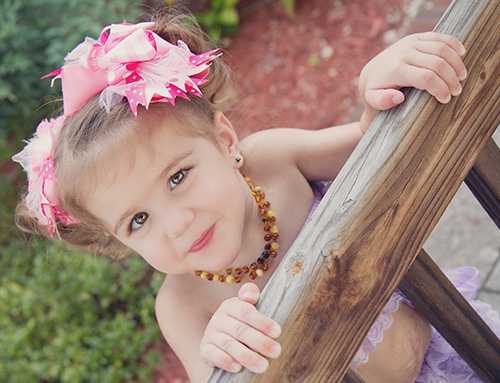
Genevieve’s Story—Written by her mom, Tiffany
Genevieve was born with gastroschisis, a birth defect of the abdominal (belly) wall. Although she has faced many hardships, her mom, Tiffany, shares what a strong and beautiful girl she is. Read her story below.
Genevieve is a twin, born early with gastroschisis. She spent three months in the neonatal intensive care unit (NICU) and needed several surgeries and countless procedures to keep her alive. Unexpectedly, she got a massive infection in her gut, which destroyed her remaining intestine. It poisoned her blood and she almost didn’t survive. Her birth defect led to problems for many organs inside of her body, and she’s needed several treatments during her life to be able to thrive on her own. Through this journey, we’ve learned that gastroschisis can range from a short stay in the NICU to a lifetime of complications. Each baby’s story is different and there is no way of knowing that path until you are already on it.
Genevieve has continued to have a few complications due to her birth defect. She will continue to struggle with things like hydration and nutrition. And, we will always have to watch her for signs of problems. But, this little girl doesn’t let any of that bother her. She is strong and beautiful and inspiring to those who know her story.

Ian’s Story – Written by his mom, Jessica
Jessica shares the story of her son, Ian, who was born with gastroschisis. Ian has experienced many health difficulties, but he loves school, his dance club, and his friends. Despite everything he has been through, he continues to endure with a smile. Read more of his special story below.
Ian was born at 32 weeks with a condition called gastroschisis, a birth defect where his intestines stick outside of his body through a hole beside the belly button. At some point in my pregnancy, the defect in the abdominal wall closed itself around the intestines outside of his body, killing all the intestines that were outside. We did not know this during the pregnancy. When he was born, we found out that he lost ½ of his colon, 2/3 of his small intestine, the valve between his small and large intestine, and his appendix. I didn’t get to see my son until the next morning and was crushed. During Ian’s nine month stay in the neonatal intensive care unit (NICU), he endured numerous feeding issues and multiple surgeries to lengthen his bowels, remove obstructions, and save him from a perforation. It was the scariest time when we were told that our baby had a 50-50 chance to pull through the next 24 hours (which happened more than one time).
After an intestinal transplant in California, we finally went home on March 3, 2008. But, it was not easy at home. Ian was in and out of the hospital with infections in his line, the tube that carried nutrients and medicine to his body, almost every six weeks. We almost lost Ian to one major infection in September 2008. He got a mutated form of a blood bug called Klebsiella, and he went into cardiac arrest in the pediatric intensive care unit (PICU). He then got a clot in his heart, his lungs collapsed with double pneumonia, and his kidneys went into failure. Everything looked as though we were losing him, but with a miracle, his blood clot went away overnight and he started to pee hours before having dialysis. He spent the entire month of September in the PICU, but when we did come home, everything just started to click. Eventually, doctors removed his line on December 31, 2008.
Since then, Ian has been receiving a monthly blood transfusion and injections to help with his severe anemia, which was caused by him having to be on heavy duty antibiotics for three years. Ian will need to have more intestine removed this summer to try to stop the bleeding inside. This leaves us very uncertain of the future. We do not know if Ian will need to go back on a feeding tube or have his line reinserted after this surgery. Ian currently receives special services for speech and development because of his long term hospitalizations. He loves school, his dance club, and his friends. Despite everything he has been through, he continues to endure with a smile—he is a true Warrior!
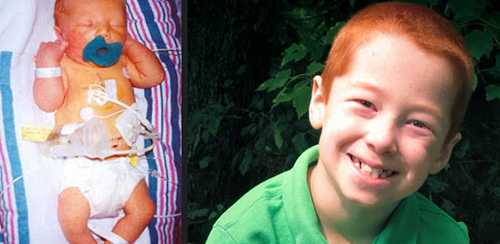
Josh’s Story—Written by his mom, Megan
Josh was born with gastroschisis. He has experienced some health issues throughout childhood, but he has also flourished and has a bright future ahead of him. Read his story below, shared by his mom, Megan.
At 18 weeks pregnant, I was told that my baby had gastroschisis, a birth defect where the baby’s intestines stick outside of the baby’s body. At 34 weeks into my pregnancy, I was induced into labor, due to worrying ultrasounds. Joshua was born at 6lbs and 10 ½ oz. Because of his gastroschisis, he lost 2/3 of his small intestine, a small portion of his large intestine, and his appendix. Because of this, he was diagnosed with short-bowel syndrome. He had to have surgery a couple days after birth to connect parts of his intestine back together, and he has had multiple other surgeries since then.
Josh has flourished in school, but he has also had some difficulty. As we’d been warned, he has a weaker immune system. He seems to catch everything that comes his way. Through this journey, we’ve learned that every day is different. One day he’ll be doing so great, and the next he will have taken three steps back.
He’s such a strong, sensitive, little boy. I know he has a bright future ahead of him, and we look forward to every moment. I can only hope that reading his story can give other parents hope.
- Page last reviewed: May 16, 2017
- Page last updated: May 16, 2017
- Content source:



 ShareCompartir
ShareCompartir